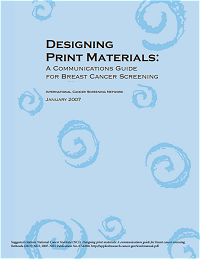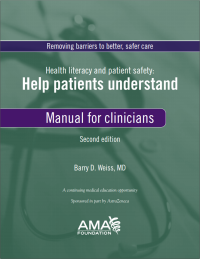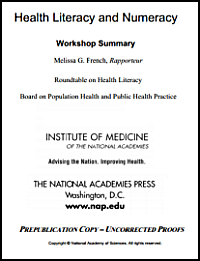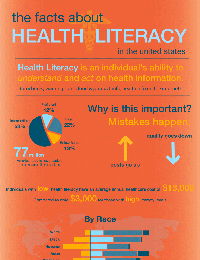Health Literacy Industry Publications
 Designing Print Materials: A Guide for Breast Cancer Screening
Designing Print Materials: A Guide for Breast Cancer Screening-
This guide was developed as part of an effort to improve the quality of the information that breast cancer screening programs provide to women. This practical guide is part of a set of activities undertaken by the International Cancer Screening Network (ICSN), a voluntary organization of members from around the world. The ICSN works to improve the quality of cancer screening by fostering collaborative efforts aimed at understanding how to use and compare data from screening programs internationally and by developing methods to evaluate the impact of these programs. As part of this effort, the ICSN has identified international quality measures that are being examined in many countries and used to improve program performance and outcomes.s
 ICSN_designing_print_materials_color- Breast cancer screenings.pdf (4.4 MB)
ICSN_designing_print_materials_color- Breast cancer screenings.pdf (4.4 MB)
 Health Literacy and Patient Safety: Help Patients Understand
Health Literacy and Patient Safety: Help Patients Understand-
Manual for Clinicians, 2nd ed.
This manual by Barry D. Weiss, MD, published by the American Medical Association Foundation, reviews the problem of health literacy, its consequences for the health care system, and the likelihood that a clinician’s practice includes patients with limited literacy. The manual then provides practical tips for clinicians to use in making their office practices more “user friendly” to patients with limited literacy, and gives suggestions for improving interpersonal communication between clinicians and patients.
 amaf_healthlitclinicians.pdf (1.5 MB)
amaf_healthlitclinicians.pdf (1.5 MB)
 IOM Health Literacy and Numeracy Workshop Summary
IOM Health Literacy and Numeracy Workshop Summary-
The Board on Population Health and Public Health Practice of the Institute of Medicine established the Roundtable on Health Literacy to foster dialogue and discussion to advance the field of health literacy and to improve the translation of research findings to health care, education, and policy. The roundtable strives to enhance mutual understanding of health literacy among the health community and the general public, and to provide a mechanism that fosters collaboration among stakeholders. To accomplish its purpose, the roundtable brings together leaders from academia, industry, government, foundations, and associations as well as representatives of patient and consumer interests who have an interest and role in improving health literacy. It also commissions papers and conducts workshops to inform its meetings.
On July 18, 2013, the roundtable conducted a workshop that featured the presentation of the commissioned paper by its authors (see Appendix A for the commissioned paper). Other presenters were invited to speak on a number of topics related to numeracy, including the effects of ill health on cognitive capacity, issues with communication of health information to the public, and communicating numeric information for decision making. The workshop was organized into four panels of speakers, each followed by a brief discussion. The chapters of this workshop summary are organized by panel presentations.
NOTE: PREPUBLICATION COPY – UNCORRECTED PROOFS
 IOM Prepub Health Literacy and Numeracy Workshop Summary.pdf (2.1 MB)
IOM Prepub Health Literacy and Numeracy Workshop Summary.pdf (2.1 MB)
 Health Literacy and AHIP: Laying the Foundation and Beyond
Health Literacy and AHIP: Laying the Foundation and Beyond-
Now in its 3rd Edition, Health Literacy and America’s Health Insurance Plans: Laying the Foundation and Beyond summarizes the health literacy programs of 31 AHIP member companies and describes their commitment to providing consumers with information on their health and benefits that can be easily understood and used to good advantage.
 Toolkit for Making Written Material Clear and Effective
Toolkit for Making Written Material Clear and Effective-
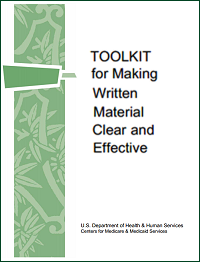
The Toolkit for Making Written Material Clear and Effective was written for the Centers for Medicare & Medicaid Services (CMS) by Jeanne McGee, McGee & Evers Consulting, Inc. As shown below, this 11-part Toolkit provides a detailed and comprehensive set of tools to help you make written material in printed formats easier for people to read, understand, and use.
Part 1: About this Toolkit and how it can help you
Part 2: Using a reader-centered approach to develop and test written material
Part 3: Summary List of the "Toolkit Guidelines for Writing and Design"
Part 4: Understanding and using the "Toolkit Guidelines for Writing"
Part 5: Understanding and using the "Toolkit Guidelines for Graphic Design"
Part 6: How to collect and use feedback from readers
Part 7: Using readability formulas: A cautionary note
Part 8: Will your written material be on a website?
Part 9: Things to know if your written material is for older adults
Part 10: "Before and after" example: Using this Toolkit's guidelines to revise a brochure
Part 11: Understanding and using the "Toolkit Guidelines for Culturally Appropriate Translation"
Toolkit Parts 1-3 and 7-11 each consists of a single document. Toolkit Parts 4-6 each consists of several documents denoting chapters. The complete set of files that make up the Toolkit is provided here:
 ToolkitPart01-03Files.zip (3.1 MB)
ToolkitPart01-03Files.zip (3.1 MB)
 ToolkitPart04Files.zip (7.8 MB)
ToolkitPart04Files.zip (7.8 MB)
 ToolkitPart05Files.zip (19.7 MB)
ToolkitPart05Files.zip (19.7 MB)
 ToolkitPart06Files.zip (13.9 MB)
ToolkitPart06Files.zip (13.9 MB)
 ToolkitPart07-11Files.zip (11.1 MB)
ToolkitPart07-11Files.zip (11.1 MB)
More information on the Toolkit is available at cms.gov/.../WrittenMaterialsToolkit.
 Infographic: The facts about health literacy
Infographic: The facts about health literacy-
From Betsy Caron, a contributing writer at HealthCare IT News, comes this interesting Infographic of health literacy in the United States. Available as a PDF file and as a large PNG grahic file.
 HealthLiteracyInfographic.pdf (1.1 MB)
HealthLiteracyInfographic.pdf (1.1 MB)HealthLiteracyInfographic_lg.png (2.4 MB)
 HHS/CMS Uniform Glossary of Terms
HHS/CMS Uniform Glossary of Terms-
Under the Affordable Care Act, health insurers and group health plans will provide the 180 million Americans with private insurance with clear, consistent and comparable information about their health plan benefits and coverage. Specifically, the proposed regulations would ensure consumers have access to a uniform glossary of terms commonly used in health insurance coverage. The jargon that makes it impossible to figure out what is covered and how one insurance plan stacks up compared to another will be replaced with terms that are the same across all plans. Insurance companies and group health plans will be required to make available upon request a uniform glossary of terms commonly used in health insurance coverage such as “deductible” and “co-pay”. For more information on these proposed HHS regulations please visit cciio.hhs.gov/programs/consumer/summaryandglossary or download a copy of the uniform glossary below.
 HHS_CMS-uniform-glossary-final.pdf (140 KB)
HHS_CMS-uniform-glossary-final.pdf (140 KB)
 Teaching Patients with Low Health Literacy Skills
Teaching Patients with Low Health Literacy Skills-
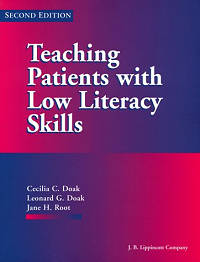
Since it was first published, Teaching Patients with Low Literacy Skills by Doak, Doak, & Root has become a major resource book for health information providers who know that their patients aren't getting the message. It addresses the mismatch between the literacy skills of Americans and the literacy demands of healthcare instruction.
This book is provided here as a series of PDF files with permission of the authors Ceci and Len Doak.
To read or download each section, click or right-click the following links:
 Doak.1.Intro.pdf (436 KB)
Doak.1.Intro.pdf (436 KB)
 Doak.2.Chap1-4.pdf (5.4 MB)
Doak.2.Chap1-4.pdf (5.4 MB)
 Doak.3.Chap5-7.pdf (6.0 MB)
Doak.3.Chap5-7.pdf (6.0 MB)
 Doak.4.Chap8-10.pdf (4.2 MB)
Doak.4.Chap8-10.pdf (4.2 MB)
 Doak.5.Appendices.pdf (1.2 MB)
Doak.5.Appendices.pdf (1.2 MB)
 Health Literacy Implications of the Affordable Care Act
Health Literacy Implications of the Affordable Care Act-
While the Affordable Care Act (ACA) does not focus explicitly on health literacy, the law's success arguably calls for a redoubling of national efforts to address the issue. Nearly 36 percent of America's adult population is considered functionally illiterate, with rates of low literacy found disproportionately among lower-income Americans eligible for publicly financed care through Medicaid.
In this report, commissioned by the Institute of Medicine, the Center for Health Care Strategies (CHCS) identifies provisions in the ACA that directly and/or indirectly address health literacy. Findings herein can inform efforts to implement related enrollment, care delivery, and public health strategies that support and respond to health literacy levels in the expansion population.
You can download this report at the CHCS wesbite:


